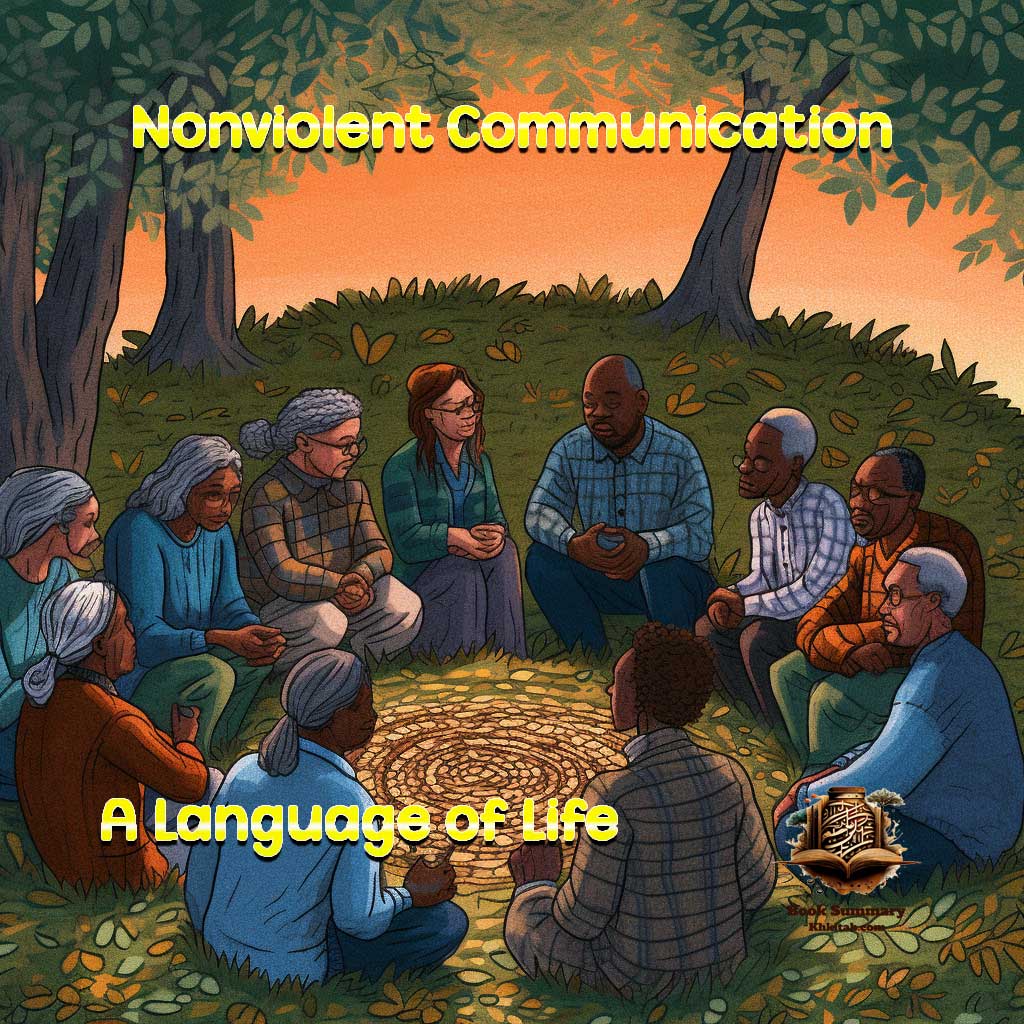Nonviolent Communication: A Language of Life Book Summary

Have you ever wondered how to improve personal and professional communications and resolve conflicts in a non-violent and positive way? This is the main theme of the book “Nonviolent Communication: A Language of Life” by Marshall Rosenberg.
This book provides the reader with a key to understanding the world of communications and human relationships. Rosenberg’s deep insights and practical tools guide us step by step towards building nonviolent communication, not just in dialogues and negotiations, but as a lifestyle that allows us to live with greater respect and empathy for others.
Table of Contents
Why is Nonviolent Communication Essential for Cultivating Meaningful Personal and Professional Relationships?
In his pioneering work “Nonviolent Communication: A Language of Life,” Dr. Marshall Rosenberg provides a transformative approach to human interactions, emphasizing the need for nonviolent communication in everyday life. According to Rosenberg, nonviolent communication is not merely a technique but a way of life that fosters empathy, understanding, and mutual respect. It transcends the boundaries of personal relationships and extends to professional relationships, profoundly impacting our interactions.
Nonviolent communication encourages a shift from competitive communication patterns, typically marked by manipulation, coercion, or avoidance, towards cooperative communication, characterized by understanding and compassion. This communication style urges individuals to express their needs and feelings openly and sincerely and receive the feelings and needs of others empathetically.
In the context of personal relationships, nonviolent communication can lead to deeper connections, fostering honesty and understanding. It can help individuals effectively express their emotions and needs, reducing misinterpretations and conflicts. By creating a safe space for open and empathetic dialogue, it enables individuals to build and sustain healthier relationships.
Within the sphere of professional relationships, the importance of nonviolent communication is even more pronounced. In workplaces marked by diversity, the ability to communicate nonviolently is crucial to fostering a cooperative and inclusive environment. This approach can reduce interpersonal conflicts, increase employee satisfaction, and improve overall productivity.
It aids in building trust among team members, fostering mutual respect, and enhancing teamwork. Leaders who employ nonviolent communication can create more transparency, inspiring their teams to work towards common goals while acknowledging individual needs and feelings.
Dr. Rosenberg’s book offers a wide array of real-life examples, stories, and practical exercises that help the readers incorporate nonviolent communication into their lives. He emphasizes that nonviolent communication is a learnable, trainable skill that can significantly enhance the quality of both personal and professional relationships.
In essence, “Nonviolent Communication: A Language of Life” underscores the importance of nonviolent communication as a vital tool for cultivating meaningful relationships. By replacing judgment and criticism with empathy and understanding, nonviolent communication opens the door to improved interpersonal interactions, fostering an environment of cooperation and respect.
How Do the Four Basic Elements of Nonviolent Communication Enhance Understanding and Connection?
In his insightful work “Nonviolent Communication: A Language of Life”, Dr. Marshall Rosenberg provides a profound framework to enhance the quality of our interactions with others. At the heart of this framework are four core elements: Observation, Feeling, Need, and Request. Rosenberg asserts that these elements, when understood and applied correctly, can significantly improve our ability to connect with others, fostering empathy, mutual understanding, and compassion.
To begin with, ‘Observation’ is the initial step of nonviolent communication. It involves observing the situation without incorporating any judgment or evaluation. By focusing solely on what we perceive through our senses, we can establish an objective understanding of the situation, free from biases and preconceptions. This skill helps us avoid unnecessary conflicts that might arise due to misinterpretations or misunderstandings.
The second element, ‘Feeling’, involves expressing our emotional state, stemming from what we observe. By clearly expressing our feelings, we allow others to understand our emotional state better and encourage them to empathize with our experience. Moreover, focusing on feelings allows us to connect with others at an emotional level, fostering understanding and connection.
Next is ‘Need’, which Rosenberg emphasizes as a significant part of our shared human experience. Every feeling we experience, he explains, is a response to a met or unmet need. By understanding and expressing our needs, we create the opportunity for others to empathize with us and work together to meet those needs.
Finally, ‘Request’ encompasses our desires regarding potential strategies to meet the expressed needs. It involves clear, respectful, and specific articulation of what we would like others to do to enrich our lives. It’s crucial to express these as requests and not as demands, to maintain respect for the other person’s autonomy and foster a cooperative relationship.
Throughout his book, Rosenberg offers practical advice and exercises for understanding and implementing these four elements in various contexts of life. The practice of these principles can profoundly affect our communication with others, enhancing mutual understanding, respect, and compassion.
In conclusion, the four basic elements of nonviolent communication – Observation, Feeling, Need, and Request – as outlined by Dr. Rosenberg, provide a transformative approach to our interactions with others. When practiced with sincerity and openness, they can open the door to deeper, more empathetic, and meaningful connections.
How Do Evaluations and Judgments Hinder Communication and How Can We Overcome Them?
In his book “Nonviolent Communication: A Language of Life”, Dr. Marshall Rosenberg explores the profound impact that evaluations and judgments can have on our communication. According to him, these mental habits can often distort our understanding and impede effective, empathetic communication. Understanding how these processes affect our conversations and learning to minimize their impact can lead to more fruitful and understanding communication.
Evaluations and judgments, while often automatic, can create barriers in our communication. When we judge or evaluate, we move away from understanding the other person’s perspective and focus on categorizing their actions or character, often in a negative light. This can lead to defensiveness, misunderstanding, and conflict.
Dr. Rosenberg proposes that to mitigate the harmful effects of judgments and evaluations, we should aim to distinguish between objective observations and our subjective interpretations. For instance, instead of stating “you are irresponsible”, which is a judgment, one might say, “I noticed you have not done the dishes for three days,” which is an objective observation. This approach facilitates communication based on shared reality rather than personal biases and prevents defensive reactions.
Furthermore, Dr. Rosenberg suggests substituting evaluations with expressing our feelings and needs. Instead of saying, “you’re selfish,” we might express our personal feelings and needs: “I feel disappointed because I need cooperation in household chores.” This shift to expressing personal feelings and needs allows the other person to understand our experience without feeling blamed or judged.
Moreover, the book advises adopting a mindset of empathetic understanding. Instead of using our energy to evaluate or judge, we should use it to understand and empathize. By seeing beneath the surface behaviors to the feelings and needs that drive them, we foster an environment of mutual respect and understanding.
The book also includes practical exercises that help to cultivate a mindset free from constant evaluation and judgment, replacing it with empathetic connection. By shifting our communication from evaluation to observation, from judgment to understanding, we can build stronger, more compassionate connections.
In conclusion, “Nonviolent Communication: A Language of Life” offers invaluable insights into how judgments and evaluations can hinder our communication. By following Dr. Rosenberg’s guidance, we can learn to communicate more effectively, fostering understanding and empathy in our interactions.
How Can Active Listening Foster Empathy and Understanding?
In his seminal book “Nonviolent Communication: A Language of Life”, Dr. Marshall Rosenberg elucidates the profound role active listening plays in cultivating empathy and promoting understanding between individuals. He argues that active listening isn’t merely an act of hearing words, but a process of comprehending, interpreting, and responding to the underlying emotions and needs expressed in a conversation. The practice can bridge gaps, dissolve misunderstandings, and create deeper, more meaningful connections.
Active listening requires full attention to the speaker and involves more than just listening to the words spoken. It demands that we also ‘listen’ to the person’s body language, tone of voice, and underlying emotions. When we actively listen, we attempt to understand the speaker’s perspective without judgment or interruption, encouraging open and honest communication.
Rosenberg notes that one of the most crucial aspects of active listening is reflecting back the speaker’s feelings and needs. By paraphrasing or mirroring their statements, we assure the speaker that their words are heard and understood, thus fostering an environment of mutual respect and trust. This process can lead to a deep empathetic connection, where both parties feel seen and valued.
The book also highlights the importance of listening for what is not said. Often, feelings and needs are left unexpressed or hidden behind judgments and evaluations. Actively listening for these unspoken emotions and needs can help us gain a deeper understanding of the speaker’s experience and foster empathy.
Another critical aspect of active listening Rosenberg discusses is resisting the urge to offer unsolicited advice or reassurances, which can often stifle open communication. Instead, he recommends focusing on understanding and empathizing with the speaker’s feelings and needs, thereby encouraging a deeper connection and promoting mutual understanding.
In conclusion, Rosenberg’s “Nonviolent Communication: A Language of Life” offers critical insights into the art of active listening, underlining its significance in fostering empathy and understanding in our interactions. By practicing active listening, we can enhance our communication skills, deepen our relationships, and create a more compassionate and understanding world.
How Can Expressing Needs Promote Effective Communication?
In “Nonviolent Communication: A Language of Life”, author Marshall Rosenberg imparts the significance of expressing needs transparently and unambiguously to encourage successful communication. He posits that the articulation of our needs, far from being a sign of weakness or selfishness, is fundamental to human interaction and mutual understanding.
Rosenberg posits that our needs often lie at the heart of our feelings and actions, yet we frequently struggle to express them for fear of vulnerability or rejection. This lack of clear communication can lead to misunderstandings, conflicts, and unmet needs. However, by learning to articulate our needs in an open and non-demanding way, we can enhance our relationships, resolve conflicts, and foster mutual understanding and respect.
In the context of Nonviolent Communication (NVC), expressing needs involves identifying what is essential to our well-being, or what we require to thrive. These needs are universal, transcending cultural and linguistic barriers, and include aspects such as autonomy, respect, and physical well-being. By framing our communication around these needs, we can create a shared understanding and mutual empathy, the foundation for effective communication.
Yet, Rosenberg cautions that expressing needs is not merely about voicing our desires. It also involves taking responsibility for our needs, without blaming or criticizing others. This approach requires a certain level of self-awareness and honesty, as we need to discern our genuine needs from our strategies or preferences to meet those needs.
Furthermore, expressing needs should not be a coercive act, aimed at manipulating others into meeting our demands. Rather, it should be an invitation for empathy and understanding. When we express our needs clearly and respectfully, we create the space for others to empathize with us and willingly contribute to our well-being.
Rosenberg’s book, therefore, highlights the significance of expressing needs in fostering effective communication. By doing so, we can create deeper connections, mitigate conflicts, and cultivate an environment of mutual empathy and respect. His insights offer valuable lessons for all individuals seeking to improve their communication skills and enhance their relationships.
How Can Formulating Clear Requests Enhance Communication and Relationships?
In his seminal work, “Nonviolent Communication: A Language of Life,” Marshall Rosenberg provides a profound discourse on the importance of formulating clear and actionable requests to meet our needs. He elucidates that many communication breakdowns stem from ambiguous or vague requests that can lead to misunderstanding, conflict, and unmet needs. Conversely, explicit and well-structured requests have the potential to improve our personal and professional relationships significantly by fostering understanding, cooperation, and mutual respect.
Rosenberg’s model of Nonviolent Communication (NVC) underscores that clear requests are the practical manifestation of our identified needs. Once we’ve discerned our own needs or those of others, the next step is to articulate what we’d like to request to meet these needs. This specificity prevents misunderstanding and gives the other person a clear path to contributing to our well-being.
However, Rosenberg points out that there’s an art to formulating these requests. A crucial aspect is that requests must be actionable and specific. Instead of vague aspirations, we should express what we would like to happen, specifying the action we desire. This concreteness not only makes it more likely that our needs will be met, but it also respects the autonomy of the other person, as they have a clear understanding of what’s being asked of them.
Another critical distinction that Rosenberg emphasizes is the difference between a request and a demand. Requests are open-ended, allowing the freedom for the other person to decline. In contrast, demands implicitly or explicitly threaten repercussions if not complied with. This dynamic can breed resentment and resistance, damaging relationships. Rosenberg, therefore, advises us to ensure that our requests genuinely allow for a free response.
Moreover, Rosenberg suggests that we remain open to negotiation when making requests. Our initial request may not always be feasible for the other party, and hence, being open to dialogue and alternative solutions can help ensure everyone’s needs are considered.
In conclusion, “Nonviolent Communication: A Language of Life” underscores the importance of clear and actionable requests in effective communication. Rosenberg’s insights are invaluable tools for anyone seeking to navigate interpersonal relationships with more clarity, empathy, and understanding.
How Can Empathy Transform Our Interactions?
Marshall Rosenberg’s influential work “Nonviolent Communication: A Language of Life” profoundly underlines the significance of empathy as a central tool in our communication process. He argues that empathy, a sincere and deep understanding of others’ feelings and needs, is the cornerstone of nonviolent communication and essential for promoting harmonious and fulfilling relationships.
Empathy, as depicted by Rosenberg, extends beyond merely understanding another’s perspective. It’s about resonating with their emotional state and genuinely connecting with their needs. This empathic connection, according to Rosenberg, is what makes nonviolent communication so transformative. It changes the dynamics of our interactions from being transactional to being relational, fostering a sense of mutual respect and compassion.
The empathic process in nonviolent communication is two-fold. It involves empathizing with others and also empathizing with ourselves. Self-empathy allows us to discern our feelings and needs clearly, which is the first step towards effective communication. Empathizing with others, on the other hand, involves active listening and openness to their feelings and needs, without judgment or attempts to ‘fix’ the situation. Rosenberg points out that this kind of presence can be far more healing and powerful than any advice or solution.
Moreover, Rosenberg believes empathy can be a route to conflict resolution. By practicing empathic listening and expressing, parties involved in a conflict can move from a position of antagonism to a place of mutual understanding, where everyone’s needs are considered. It’s this empathic connection that allows for collaborative solutions to emerge, where everyone’s needs are met to the best extent possible.
Rosenberg’s perspective on empathy also touches upon the concept of ‘giving from the heart.’ He asserts that empathy leads us to a natural desire to contribute to others’ well-being. This compassionate giving, which arises from understanding and connecting with others’ needs, is different from compelled or duty-bound giving, which often leads to resentment or burnout.
In summary, “Nonviolent Communication: A Language of Life” asserts that empathy is more than a skill – it is a mindset and an approach that can revolutionize the way we communicate and relate with others. By harnessing empathy, we can foster deeper connections, resolve conflicts more amicably, and create relationships that are rooted in mutual respect and understanding.
How Can Nonviolent Communication Foster Constructive Conflict Resolution?
Conflict is a natural part of human interaction, and how we handle these disagreements often determines the quality of our relationships and our personal wellbeing. In “Nonviolent Communication: A Language of Life”, Marshall Rosenberg provides invaluable strategies for resolving conflicts in a nonviolent, constructive, and empathetic manner.
Rosenberg presents conflict not as an impasse, but as an opportunity for growth, mutual understanding, and deepening of relationships. The first step towards this positive perspective is to abandon the mentality of ‘winners’ and ‘losers.’ Instead, the goal of conflict resolution, according to Rosenberg, is to ensure that the needs of all parties involved are acknowledged and met as fully as possible.
In the process of nonviolent conflict resolution, Rosenberg emphasizes the importance of four components: observation, feeling, need, and request. It starts by neutrally stating the observed action that’s contributing to the conflict without embedding any form of judgement or evaluation. The next step involves identifying and expressing how one feels in relation to what was observed. This is followed by stating what need isn’t being met, leading to these feelings. Finally, a clear, concrete, and feasible request is made to address the unmet needs.
A key part of Rosenberg’s strategy is active, empathetic listening. Even when tensions are high, he encourages individuals to attentively listen to the other party’s feelings and needs. This empathetic presence can significantly diffuse the conflict and open doors for effective dialogue and mutual understanding. By doing so, it allows us to respond from a place of empathy rather than react impulsively, which often exacerbates the conflict.
Moreover, Rosenberg’s process encourages collaborative problem solving. Once all parties understand and acknowledge each other’s needs, they can collaboratively explore strategies to meet these needs. This replaces adversarial dynamics with a spirit of cooperation and goodwill.
Rosenberg’s approach is revolutionary in that it reminds us that even amidst disagreements, we can communicate with empathy, respect, and sincerity. By focusing on shared human needs rather than the contentious details of a disagreement, nonviolent communication allows us to navigate conflicts in a way that fosters connection, mutual understanding, and meaningful solutions. Hence, “Nonviolent Communication: A Language of Life” not only teaches us how to resolve conflicts but also imparts the skills for creating empathetic and enriching relationships.
How Can We Apply Nonviolent Communication in Our Daily Lives?
Effective communication is an essential aspect of our daily lives, and Marshall Rosenberg’s “Nonviolent Communication: A Language of Life” offers a powerful approach to communicating more compassionately and constructively. But how do we take these principles off the page and integrate them into our daily interactions?
Rosenberg provides practical exercises and illustrative examples to help readers understand and practice the four fundamental components of Nonviolent Communication (NVC): observation, feelings, needs, and requests.
A practical way to apply NVC starts with self-awareness, and this begins with observing our own communication patterns. Are our statements free from judgment? Are we clearly expressing our feelings without blaming others? Are we identifying our needs and making clear requests to meet them?
One practical application of NVC is in familial relationships. Often, families fall into patterns of communication that involve blame, judgement, and misunderstanding. By employing NVC principles, family members can begin to hear one another without immediate defense or judgement. A parent, for example, may express a concern to their child by observing a specific behavior, stating their feelings about that behavior, identifying the needs that are not being met, and making a request to address those needs.
In professional settings, NVC can help create a more cooperative and productive environment. For instance, in a team meeting, rather than criticizing a colleague’s proposal directly, one might use NVC to express their concerns about the proposal, their feelings, their unmet needs, and offer a concrete suggestion for improvement.
Rosenberg’s book also offers exercises to practice empathy, another crucial aspect of NVC. One such exercise is called “empathetic listening”, which involves repeating back to the speaker what you understood from their words, without adding your own interpretations. This can be practiced in everyday conversations with friends, family, and colleagues, and helps to ensure that we fully understand the other person’s perspective and feelings.
Lastly, Rosenberg encourages the application of NVC in self-talk. Often, we are hardest on ourselves in our internal dialogues. Applying NVC can help transform self-deprecating thoughts into an understanding of our own unmet needs and constructive ways to address them.
Practicing NVC can certainly be challenging, as it often requires us to change long-standing communication habits. However, the practical applications of NVC in “Nonviolent Communication: A Language of Life” provide a robust toolkit to navigate everyday communications with empathy, clarity, and effectiveness. It serves as a roadmap, guiding us towards a more compassionate and understanding way of connecting with ourselves and others.
What Are the Philosophies That Guide Us Towards More Compassionate Conversations?
Marshall Rosenberg’s groundbreaking book, “Nonviolent Communication: A Language of Life”, is not just a guide to effective communication, but also a deep exploration of the philosophy underpinning this approach. Rosenberg introduces us to an array of core values and ideas such as mutual respect, compassion, understanding, and shared humanity which serve as guiding principles in this method of communication.
The cornerstone of nonviolent communication lies in the understanding that all human beings have the capacity for compassion and empathy, and that our natural state is to connect with others in a compassionate manner. However, our socialization often leads us to communicate in violent and aggressive ways. Rosenberg’s philosophy proposes a shift from this paradigm to a more empathetic and understanding form of communication.
Mutual respect is another significant principle that stands firmly in this philosophy. It underscores the idea that each individual’s needs and feelings are valid and deserving of consideration. This respect extends to ourselves as well, reminding us to treat our own feelings and needs with the same regard as we do for others.
The philosophy of nonviolent communication also puts a heavy emphasis on personal responsibility. It encourages us to take ownership of our feelings and reactions, rather than attributing them to other people or external circumstances. By recognizing that our feelings are responses to our needs and expectations, we can communicate more effectively and compassionately.
Another key element in Rosenberg’s philosophy is the belief in the abundance of resources. Often, conflicts arise from the perception of scarce resources, leading individuals or groups to engage in power struggles. However, Rosenberg advocates for the understanding that resources are abundant and that everyone’s needs can be satisfied without compromise, if we approach solutions with creativity and collaboration.
Finally, Rosenberg also introduces the concept of ‘giving from the heart.’ This idea is rooted in the belief that contributing to the well-being of others leads to our own fulfillment. Therefore, our communication should always aim to enrich each other’s lives through empathy and mutual understanding.
In conclusion, the philosophy behind nonviolent communication presents a transformative approach to the way we interact with others and ourselves. It goes beyond the mechanics of effective communication and delves into a way of being that promotes mutual respect, understanding, and compassion. As such, “Nonviolent Communication: A Language of Life” serves not just as a communication handbook, but also a philosophical guide to a more empathetic and interconnected life.








